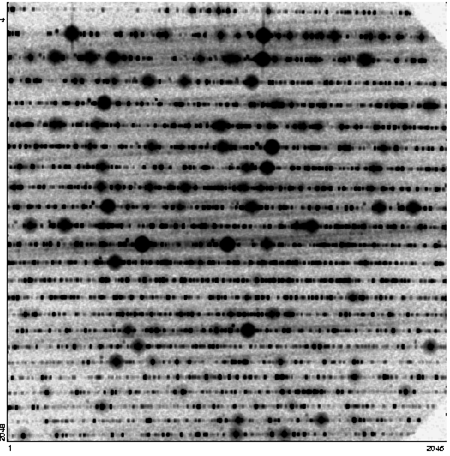|
IPMG:
STIS Calibration Enhancement
|
ST-ECF
|
|
Wavelength Calibration
-
Summary:Any spectrograph with either a long slit (extension perpendicular to the prime dispersion direction) or with a cross-dispersion capability (especially echelle spectrographs with cross-disperser) produces in the focal plane of the spectrographs camera an image where the spectral information and the spatial information on sky are convoluted to some degree. Added to this geometric transformation are the distortions of the optical arrangement. STIS has many different operating modes of that kind: single grating with long slit, mdoerate resolution gratings with cross-disperser and extended slit, high resolution echelle modes with cross-disperser and slits extending a few arcseconds so that bands of orders are produced for extended objects.

Traditionally the spectral extraction and wavelength calibration of such convoluted 2D data has been broken up into several sequential processes whereby (a) the spatial information is reduced first (eg. collapsing the counts along the slit for each spectral resolution element) - called spectral extraction - , then (b) in case of cross-dispersed spectra the spatially arranged orders are dealt with as if they where separately recorded extended spectra - called order extraction, and finally (c) the so obtained single dimensional spectra are assigned central wavelengths for each spectral resolution element. Whenever the spatial and spectral information is not well aligned with the cartesian grid of a detector - and this is always the case if it is only for the optical distortions - then the traditional procedure requires that for each of the steps (a), (b) and (c) the pipeline needs geometrical information on where to find what on the frame. The system therefore has to be fed with reference files containing the tilt of the spatial (slit image) and spectral (order location) information in pixel space. Finally a dispersion solution has to be made available for each spectral order seperately.
In addition, since the traditional extraction / wavelength assignment procedure attempts to use a linear model for the back-projection of a convoluted projection, either the sectral extraction, or - more often - the dispersion solutions contain in addition all the optical (geometric) distortions that where there originally.
A good way of appreciating the convolution of spectral and spatial information on an echellogram is this very deep wavelength calibration exposure, which clearly shows for the brighter lines in each order how their extended spectral wings "scatter" at angle to the location of the same wavelength in the neighbouring orders. On top of that the very brightest lines also produce visible almost point like ghosts (to the left, a little raised above the order).

In summary - the traditional approach is easy to scetch out on paper - but is very demanding on the operational support: whenever the slightest modification of the optical setup occurs (movement of gratings, movement of point sources along the spatial direction in the slit, temperature dependencies of focal distances or bending of the optical bench elements) the full suite of reference files need to be rederived if one wants to preserve the level of quality of the calibration pipeline products.
Our model based approach to improve the quality of STIS pipeline output utilizes the predictive power of a physically correct spectral ray trace model of each STIS spectral mode to feed the pipeline with the "where is what" information required for the above described extraction. This model corrrectly predicts the movements and shape changes of orders and spatial information on the 2D detector array with modifications of tilt agles and positions of all the optical elements. In this high zoom, smoothed extract from a E140H wavecal image one can see the predicted location of the centroid of lines as white squares. Note: One of the brightest lines has - as yet - no prediction. See our lamp project to learn more.

Consequently, the high intrinsic quality of this approach to spectral extraction and wavelength calibration can be made available to the STIS user by implanting the model code into the STIS pipeline proper, and by supplying a suite of tools which use this model semi-automatically to produce the special reference files of the model.
- Documentation:
- Status: A test version of the modified "calstis" pipeline is currently used to validate the concept and to verify the quality against the standard "calstis". The proto-type package of tools for reference file generation has been tested on a few modes. A production version is under way, and will be used in Fall 2004 to supply the full set of reference data for all STIS echelle modes. A full release of the software will be made available to STScI by mid 2005.
Back to STIS Calibration Enhancement
|